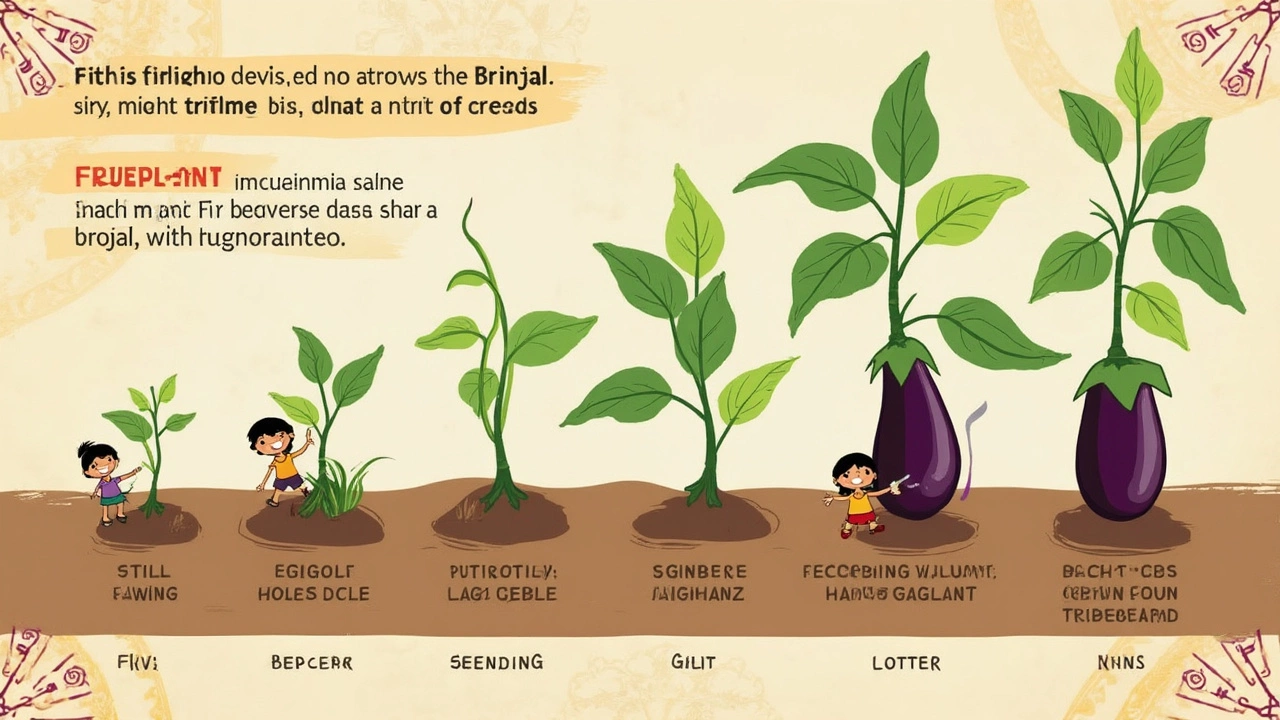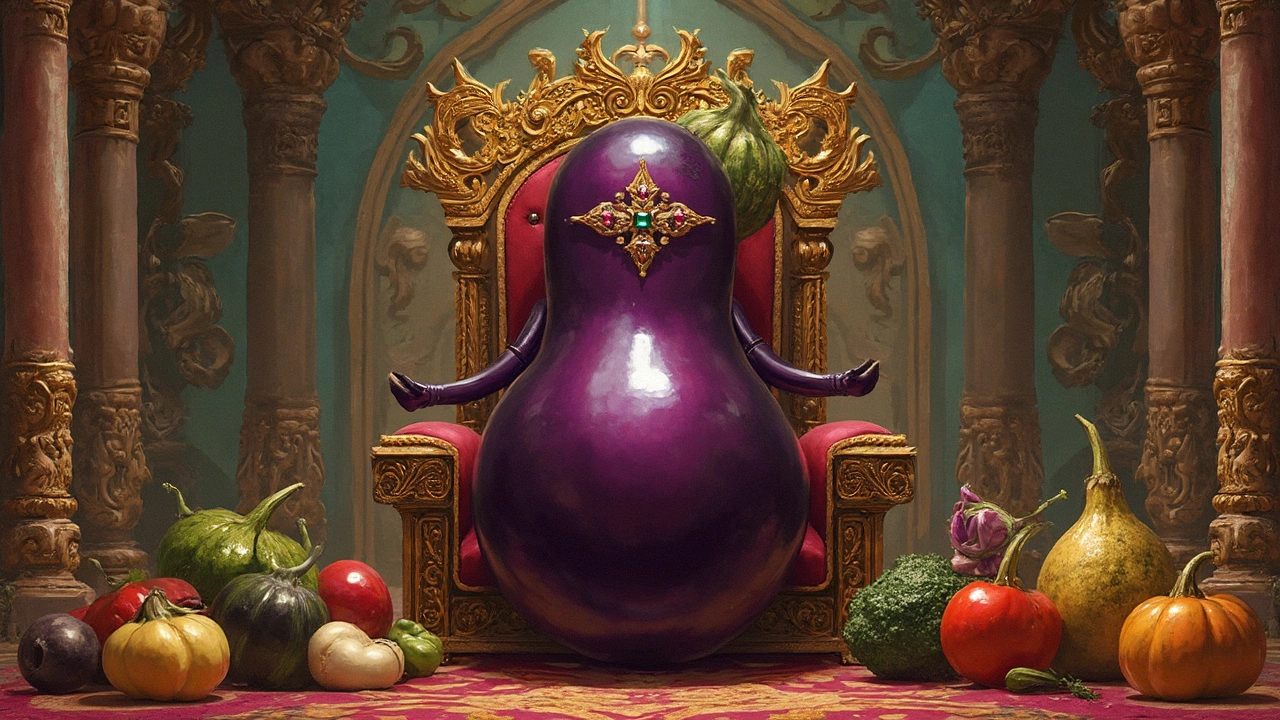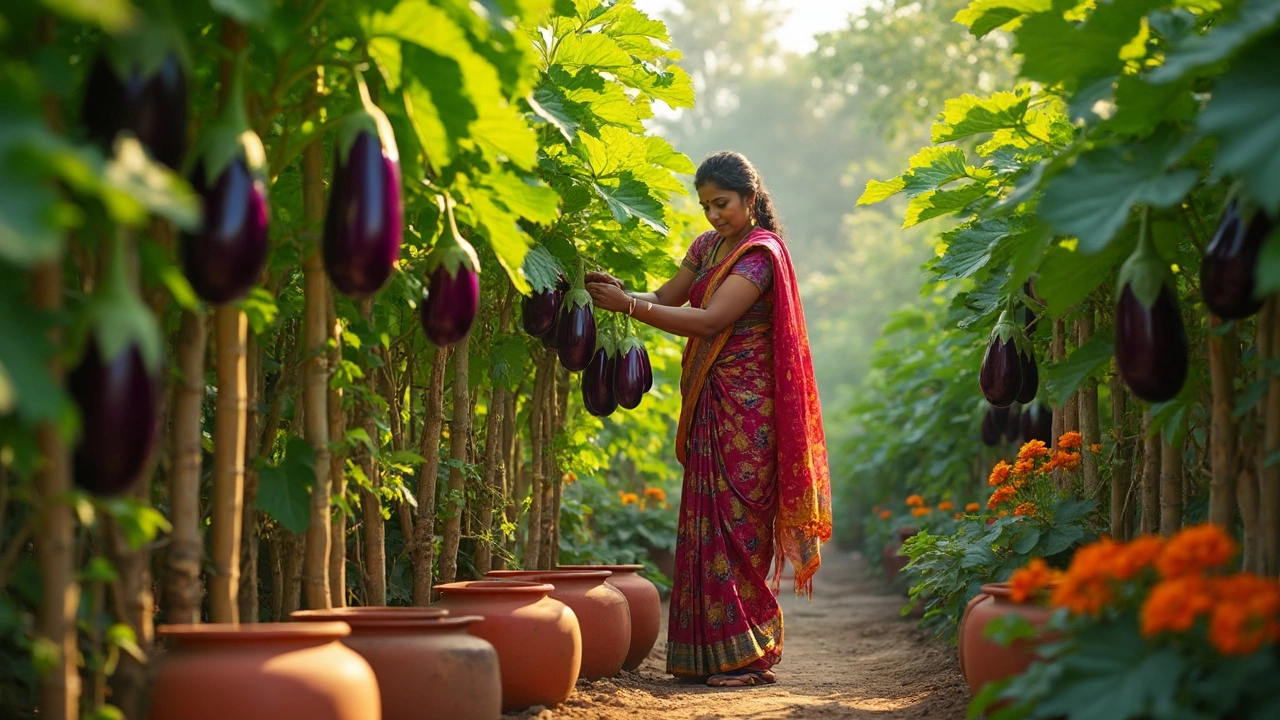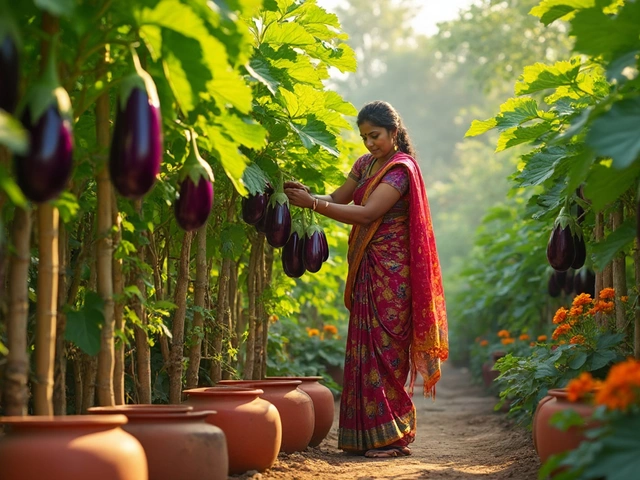When you hear ‘queen of vegetables,’ you might picture something fancy or exotic—maybe broccoli, or a rare artichoke. Surprise! In Indian kitchens and gardens, it’s the brinjal, or eggplant, that wears the crown. Sounds odd? After all, it’s technically a fruit! But across India, this veggie rules the garden beds, thanks to its bold taste, easy growth, and classic spot in dishes like baingan bharta and bharwa baingan.
If you’re thinking of growing your own brinjal, you’re in great company. It’s pretty forgiving for new gardeners. With the right soil, some sunlight, and regular watering, even a small patch or a big pot on your balcony can give you a steady harvest. Want to know why it’s labelled a ‘queen’ despite being a fruit? Or the secret tricks to get those plump, glossy eggplants? Stick around—there’s more to this versatile plant than meets the eye.
- Why Eggplant Is Called the Queen of Vegetables
- Botanical Oddities: Fruit or Vegetable?
- Brinjal Varieties Loved Across India
- How to Grow Healthy Brinjal at Home
- Common Problems and Easy Fixes
Why Eggplant Is Called the Queen of Vegetables
So why do people in India call eggplant (or brinjal) the queen of vegetables? First off, you'll find this veggie in kitchens from Kashmir to Kanyakumari. Its popularity isn't just about taste. Brinjal is super versatile—you can fry it, grill it, stuff it, turn it into spicy curries, or even mash it up for street-side bharta. There’s hardly any part of the country where eggplant doesn’t show up at family meals or festivals.
But it’s more than just a kitchen favorite. Eggplant grows well in different soil types and weather, which makes it friendly for home gardeners. Its smooth purple skin and fat, round shape stand out in the market, giving it a regal look. Historically, Indian texts and food traditions have put brinjal on a pedestal. Even Ayurveda mentions its health benefits like helping with digestion and lowering cholesterol. In fact, it’s the only common Indian vegetable to have so many diverse types—long, round, green, purple, striped—in one crop.
If you look at old farming books from the 19th century, Indian experts regularly praised eggplant for its "royal" place in the veggie world. It was more accessible and easier to grow than many other crops claimed to be luxurious but needed tricky care.
Here's a quick look at how brinjal stacks up against popular Indian vegetables in terms of use and harvest:
| Vegetable | Common Uses | Harvest Seasons per Year |
|---|---|---|
| Eggplant (Brinjal) | Curry, fries, roasted, stuffed | 2-3 |
| Potato | Curry, fries, mashed, chips | 1-2 |
| Tomato | Curry, chutney, salad | 2 |
| Okra | Fried, curry, stuffed | 2 |
And don’t forget looks matter too! When you see a shiny purple brinjal sitting at the top of a veggie heap, it immediately draws your eye. It’s the veggie that farmers proudly display for shows and even use in wedding decorations in some regions. No wonder it earned its queenly title.
Botanical Oddities: Fruit or Vegetable?
This question—brinjal, is it a fruit or a vegetable?—gets gardeners and cooks debating all the time. Here's the simple answer: botanically, brinjal (or eggplant) is a fruit. Why? Because it grows from the flower of the plant and contains seeds. That’s the textbook definition of a fruit. But when it comes to cooking, in India and most of the world, it lands in the ‘vegetable’ slot because it’s used in savoury dishes.
This fruit-versus-vegetable mix-up isn’t limited to eggplant. Tomatoes, cucumbers, and pumpkins are also technically fruits but usually called veggies in the kitchen. So it’s not just eggplant fooling everyone!
Here’s a quick table showing the difference between a botanical fruit and a culinary vegetable, just to make things less confusing:
| Botanical Term | Everyday Cooking Term | Examples |
|---|---|---|
| Fruit | Usually called vegetables in cooking | Eggplant, Tomato, Cucumber |
| Vegetable | Same in both | Potato, Spinach, Carrot |
Still wondering why people care so much about the technicalities? The main reason is garden planning. Fruits need different nutrients and care compared to leafy or root vegetables. If you’re growing your own brinjal in your Indian vegetable garden, knowing it’s a fruit means you’ll want to give it similar sunshine, space, and watering as other fruiting plants like tomatoes.
Bottom line: in the kitchen and market, brinjal is the queen of vegetables. But in the world of plant science, it’s just another sneaky fruit pretending to be a veggie.

Brinjal Varieties Loved Across India
Check out any region’s market or home garden and you’ll find more kinds of brinjal (eggplant) than you might expect. India actually leads the world in brinjal diversity. There’s no ‘one size fits all’ here—the type you grow can really make a difference in taste, size, and even cooking style.
Here are some of the country’s favorite varieties:
- Purple Long Brinjal: Super common in North India, these are slender and deep purple, perfect for bharta and fries. They grow well even in smaller kitchen gardens.
- Green Brinjal: Popular in the east, especially Bengal. These are mild and cook fast—a go-to for daily sabzi or fritters.
- Round Brinjal (Bharta Brinjal): You’ll see these in Maharashtra and Gujarat. They’re big, round, and perfect for making smoky baingan bharta.
- White Brinjal: Not as widely grown but loved for its mild flavor and fewer seeds. Works great in curries and is said to be gentler on the stomach.
- Striped or ‘Turaiya’ Brinjal: Found commonly in South India and in Andhra kitchens. With a shiny purple-and-white pattern, they look as interesting as they taste!
What really matters is picking a variety that suits your local climate and your cooking style. For small spaces, go for compact bushy types. If you have more room, the larger fruiting ones give a higher yield.
| Region | Popular Variety | Main Use |
|---|---|---|
| North India | Purple Long | Bharta, fries |
| Bengal | Green, Small Round | Fritters, curry |
| Maharashtra/Gujarat | Round Brinjal | Baingan bharta |
| South India | Striped, Purple Round | Stir-fry, sambar |
| Pan-India | White Brinjal | Curry, roasting |
If you want to try something unique, look for seeds in local fairs or ask a fellow gardener—many folks still swap heirloom queen of vegetables varieties passed down through families. Whatever you pick, patience pays off: home-grown brinjal beats store-bought, every single time.
How to Grow Healthy Brinjal at Home
Getting started with brinjal at home is way easier than you think. You don’t need fancy equipment—just basic pots or grow bags, some soil, sunlight, and a bit of patience. Here’s what works reliably in most Indian climates.
- Pick the Right Spot: Brinjals are sunlight lovers. At least 6 hours of direct sun daily is ideal. Balcony or terrace spots work great if you’re in the city.
- Soil Prep Matters: Use loamy, well-draining soil with good organic content. Mix in compost or old cow dung—brinjal plants get hungry pretty quick.
- Sow or Transplant Carefully: Start seeds in small pots or seedling trays. Move them to large containers or garden beds once 4-5 leaves pop up and stems feel sturdy. Keep 1 to 1.5 feet between plants so roots don’t tangle.
- Water the Smart Way: Keep soil moist, not soggy. Let the top inch dry before each watering. Overwatering kills roots fast, so don’t drown your brinjals.
- Feed Your Plants: Add a bit of organic fertilizer every two weeks. Wood ash or neem cake is solid for pest control and extra nutrition.
- Support the Stems: Once fruits start growing, some varieties get heavy. Use bamboo stakes or sticks to prop up the main stem and prevent snapping.
If you want a rough idea for timing: you can sow seeds between February and April for a summer harvest, or between June and July for a rainy season batch. You’ll usually spot flowers in about 6-8 weeks, and fruits will follow pretty soon after that.
| Step | What to Do | Tip |
|---|---|---|
| 1 | Sow seeds in trays | Keep trays humid, don’t let them dry out |
| 2 | Transplant seedlings | Harden off plants a week before moving |
| 3 | Water regularly | Morning is best; avoid wet leaves at night |
| 4 | Fertilize every 2 weeks | Stick to organic for tastier brinjals |
| 5 | Stake tall plants | Use old cloth strips to tie gently |
Don’t forget—look out for pests like aphids and mealybugs. A quick spray of neem oil or soapy water keeps most bugs away. Harvest your eggplants when they look shiny and feel firm. Waiting too long makes them seedy and bitter. Fresh, homegrown brinjal beats anything from the market, hands down.

Common Problems and Easy Fixes
No matter how tough brinjal (that’s eggplant for you) can be in the Indian garden, it still comes with its share of headaches. But don’t sweat—most of these have easy fixes you can try at home.
1. Leaf-Eating Pests: Brinjal leaves often turn into lunch for bugs like aphids, whiteflies, or the annoying brinjal shoot borer. If you spot tiny holes or black-spotted droppings, you probably have an infestation on your hands.
- Pick off visible caterpillars and squish them—sounds icky, but it works!
- Spray a mild neem oil solution (5ml neem oil, a drop of dish soap, and 1 litre water) every week.
- Use sticky traps for whiteflies, and always check the undersides of leaves.
2. Wilting Plants: If your plant is drooping and feels floppy, it’s not always a water issue. Wilt and root rot are common in brinjal during monsoon when the soil stays soggy for days.
- Make sure your pots or beds drain water quickly. Add sand or cocopeat to improve drainage.
- Let the soil dry a bit before the next watering.
- Remove any dying plants right away to stop disease from spreading.
3. Poor Fruit Set: Sometimes, even healthy plants won’t give you those glossy purple fruits. If you just get flowers and no fruit, it’s usually a pollination issue or a nutrient gap.
- Lightly shake the plant to help pollinate (especially in closed balconies).
- Add phosphorus-rich organic manure—brinjal loves it.
- Mulch the soil to protect roots and keep moisture even.
| Problem | Quick Fix |
|---|---|
| Yellow leaves | Check for waterlogging, cut back on watering, use well-drained soil |
| Curled leaves | Spray neem oil, remove affected leaves, watch for mites |
| Stunted growth | Fertilize with compost every month, make sure there’s enough sunlight |
Honestly, most queen of vegetables dramas come down to too much water, lack of sunlight, or sneaky pests. Keep an eye out, react fast, and you’ll have a steady supply of homegrown brinjal no matter the season.



